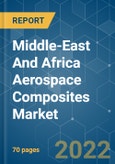The Middle-East and Africa aerospace composites market is expected to exhibit a growth rate of more than 4% during the forecast period (2020 - 2025).
Key Highlights
- The development of the regional aviation industry and rise in air passenger traffic in the Middle-East and Africa region is leading to the procurement of new commercial and general aviation aircraft by major airlines, businesses, etc. This is propelling the demand for aerospace composites in the region since composites are a major constituent in the newer generation aircraft.
- The investments in space development and exploration programs by countries such as Saudi Arabia and Israel are driving the market growth for advanced composites in the region. In December 2018, Saudi Arabia launched 2 new remote surveillance satellites as part of the Saudi Vision 2030 program. The demand for advanced composites is rising owing to their lightweight, thermal, and chemical resistant properties, reduced tooling and machining cost, etc.
- The rise in military spending by governments on stealth technology, weight reduction manufacturing, etc. is driving the demand for composite materials in defense aircraft manufacturing.
Key Market Trends
Commercial Aviation Segment to Exhibit the Highest Growth Rate
The growing air passenger traffic in the Middle-East and Africa region is propelling the market growth for new narrow-body and wide-body aircraft. In 2019, Emirates signed a USD 16 billion deal with Airbus for the procurement of 50 new A321XLR aircraft. Airbus will also start the delivery of 11 new 321neo and 4 new A321XLR aircraft to Middle-East airlines from 2020. Airbus uses materials such as Carbon Fibre Reinforced Plastic which provides a high strength to weight ratio and high resistance to corrosion. The lower weight of composite made aircraft provide high fuel efficiency and load capacity as well. Aircraft such as Airbus A350 XWB and Boeing 787 is made up of more than 50% composite materials. Airbus is currently testing 4D printing technology and digital materials which will change the physical structure on coming in contact with environmental forces. Such developments and increasing orders from the region will propel the growth of the market during the forecast period.
United Arab Emirates to Witness the Highest Growth Rate During the Forecast Period
The United Arab Emirates is one of the largest importers of weapons in the region and it has significantly increased its spending on procurement of new defense aircraft. In 2019, United Arab Emirates inked a USD 618 million deal with Calidus LLC for the procurement of 24 B-250 light attack aircraft. The new B-250 aircraft will feature extensive use of composites. The country’s initial request for procuring F-35 advanced aircraft was turned down by the United States and in 2019, United Arab Emirates showed interest to join the Su-57 development program after Russia made an offer to produce some parts of the aircraft in the United Arab Emirates. In 2017, United Arab Emirates placed an order for 5 Airbus C-295 aircraft from Airbus. In 2019, the United Arab Emirates also inked a USD 830 million deal with the United States for the procurement of CH-47F helicopters. In 2017, Chinook cleared multiple tests for its Advanced Chinook Rotor Blades (ACRB) that provides 1500 pounds of additional lift to the aircraft. The ACRB is a new fully composite blade with a swept-tip design. Due to the rise in business and tourism travel in the country, domestic airlines such as Emirates are expanding their fleet by procuring new aircraft. In November 2019, Air Arabia placed a USD 14 billion order for the procurement of 120 Airbus A320 aircraft.
Competitive Landscape
The Middle-East And Africa aerospace composites market is consolidated with players such as Solvay S.A, Saint-Gobain SA, Hexcel Corporation, DuPont Inc., etc. dominating the market. The market is marked by the presence of international suppliers of composites for aircraft companies such as The Boeing Company, Airbus SE, Lockheed Martin Corporation, etc. The market players are heavily investing in the development of material technology while subsequently upgrading the existing materials. The supplier and manufacturing contracts provided by the aircraft manufacturers and MRO service providers are the main source of revenue for the market players.
Additional Benefits:
- The market estimate (ME) sheet in Excel format
- 3 months of analyst support
This product will be delivered within 2 business days.
Table of Contents
Methodology

LOADING...








